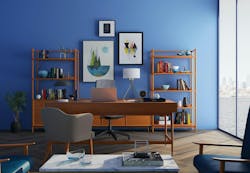4 Interior Design Considerations for Promoting Well-Being
With roughly 59% of Americans currently working from home all or most of the time, many have begun to experience their dwellings in new and challenging ways. As many as 70% report persistent lower-back and leg pain, and more than 75% of doctor office visits are for stress-related ailments.
Interior design firm Mary Cook Associates (MCA) recently released a white paper touting the health and wellness benefits of good interior design. The paper is the fourth in an eight-part series from MCA highlighting the ways developers and builders of multifamily and single-family housing can respond to recent shifts in home life.
The latest paper, titled Can Good Design Be Good For Your Health?, details four design areas that have been found to impact both physical and emotional well-being: scale, proportion, proxemics, and ergonomics.
THE FOUR ESSENTIAL AREAS OF DESIGN
1. Scale
Part of the “Holy Grail” of design, scale ensures a harmonic balance between objects in a room. As the white paper puts it, scale is “hard to articulate, but you know when it’s off.”
Think of the ceiling height, or the size of the coffee table next to that sofa. Proper scale contributes to the emotional aspects of well-being.
2. Proportion
In conjunction with scale, proportion is the relationship between the sizes of different parts, things, and elements.
When scale and proportion are balanced and work cohesively, the design feels complete. Think of nature—biophilic design, perhaps—to guide the flow of the room and the elements within. Harmoniously designed spaces can create a sense of calm while reducing stress and promoting relaxation, the paper finds.
"When a space is well-designed people find themselves lingering longer, inviting more friends and feeling more enjoyment." — Josh Kassing, Vice President, Design Development, Mary Cook Associates
3. Proxemics
Proxemics refers to the study of space, how we use it, and how it makes us more or less comfortable.
In post-pandemic design, this includes the long-term impact of social distancing, including comfort levels with proximity to others and a preference for open or outdoor spaces.
For many, proximity to others in an enclosed space has actually become a point of stress, and designers need to respond accordingly. For example, in multifamily amenity design, movable dividers and pocket spaces such as booths and seating nooks provide residents with a sense of separation, while still feeling like a part of a larger community space.
4. Ergonomics
Ergonomics is the process of designing or arranging workplaces, products, and systems so that they fit the people who use them.
One pertinent ergonomic challenge in the home is designing for remote work. Seating and surfaces designed for relaxation or a short meal are often not suitable as long-term work stations. As work-from-home becomes permanent for many homeowners, it’s critical to consider creating flexible living spaces and amenities that can double as a work area.
Good ergonomics can increase productivity while reducing fatigue and pain.
KEY TAKEAWAY
Entering into the third year of the pandemic, the effects of the coronavirus—both direct and indirect—has reshaped how we live and work as well as blurred the lines between the two.
“From working remotely to virtual learning to simple isolation, this new way of life is having some serious side effects,” says Mary Cook, founder and president, MCA.
Stress is a killer. As many Americans suffer from remote-work isolation and current affairs anxiety, the last thing they need is a home with added problems. By naturally implementing these design elements, people and communities will maximize their potential.
For more insights, check out the key takeaways from MCA’s previous white paper, Living It Up, where we highlight the “5 Ps” of home design in the age of remote work.
To download the report or read more about how Mary Cook Associates uses psychographics, an understanding of target markets, and insights into shifting lifestyle needs, check out the full white paper on Mary Cook’s website.
